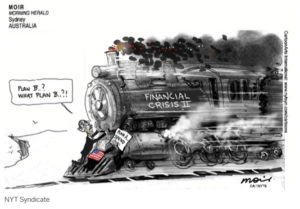
Revisiting the Myth
As the firm outlined in the February 6, 2020 article titled “The Shareholder Ownership Myth” stock ownership does not equate to a physical or legal claim to a corporation’s assets, contrary to mainstream belief. The share is the intangible piece of property that the investor owns; it is not a corporation’s assets.[1] The belief a shareholder is granted ownership rights upon purchasing shares of a publicly-traded company comes from principal-agency theory. The principal-agency theory states the following assumptions:[2]
1). Shareholder own corporations
2). Shareholders are the “residual claimants or owners” i.e. they receive all profits left over after the corporation’s contract obligations to its creditors, employees, customers, and suppliers have been satisfied
3). Shareholders are principals who hire executives to act as their agents
Mass media outlets and business schools use principal-agency theory as the basis for their programming and curriculums. The firm’s article, “The Shareholder Ownership Myth” debunks the above assumptions briefly. However, this article will analyze the second assumption of principal-agency theory, debunk the assumption with concrete evidence, and provide a real-world example in support of the firm’s stance.
The Residual Owner Theory
The second assumption states shareholders are the residual owners, i.e. they receive all profits left over after the corporation’s bondholders have been paid. This assumption is known as the residual owner theory. Residual owner theory assumes when a publicly-traded corporation files for Chapter 7 or 11 of the Bankruptcy Code, the company’s capital providers would receive their money back in the following order:
- Secured bondholders
- Unsecured bondholders
- Preferred stockholders
- Common stockholders
To illustrate an example, assume a public corporation with $100 million in assets owes $30 million to secured bondholders and $200 million to unsecured bondholders. If the bankruptcy system followed the residual owner theory, it would follow this order. First, the secured bondholders would be paid in full and would not receive an interest in the corporation’s assets. Then, the unsecured bondholders would receive the remaining amount of $70 million. The unsecured bondholders would also become owners of the firm and retain full control of the corporation.[3] The residual owner theory is disproven if two conditions are unable to be satisfied. Further details regarding the residual owner theory and the two conditions are provided below.
The Bankruptcy Law Study
“The law of corporate reorganizations should focus on identifying the residual owner, limiting agency problems in representing the residual owner, and making sure that the residual owner has control over the negotiations that the firm must make while it is restructuring.”
-Douglas G. Baird and Thomas H. Jackson (1988)[4]
Two conditions must be met in order for the residual owner theory to be true; the owners’ identities and the corporation’s value must be known. A 16-year bankruptcy law study conducted by legal professors Douglas G. Baird and Thomas H. Jackson concluded the theory of a residual owner in publicly-traded companies is a myth; a residual owner does not exist.
The identities of bond and stockholders in a public corporation are unknown and since shares are easily transferable, it makes it impossible for bankruptcy courts to correctly identify the owners of a public corporation. The bankruptcy law study found that a typical reorganizing corporation has four investor priority levels underneath secured bondholders. The fact that many priority levels exist also makes it difficult to identify a residual owner. [5] Bankruptcy courts have noted the following conflicts of interest that arise when trying to identify a residual owner. If a bankruptcy court were to identify a bond and stockholder as a residual owner, those persons would be granted entire control of the corporation. If granted control, shareholders would opt to invest the corporation’s cash in high-risk, high-return choices suitable to their investment needs while bondholders would choose to invest the corporation’s cash in low-risk, low-return investments. Since both residual owners are not on the same page about how the corporation should grow, their interests would conflict. Additionally, a conflict may also arise when a bondholder is a stockholder and vice versa. In either case, neither the bondholder nor the stockholder’s interest are in alignment with the corporation and therefore the residual ownership approach to governing publicly-traded companies’ bankruptcy proceedings fails.[6]
The second issue with trying to govern bankruptcy proceedings using the residual owner theory is determining the value of a corporation’s assets. A valuation of the firm’s assets would be needed to transfer ownership in the event a residual owner could be identified.[7] However, valuation is expensive and difficult to obtain as a publicly-traded firm’s assets may fluctuate during bankruptcy proceedings. A judge cannot determine a firm’s value since a person cannot own a corporation and have control over it, nor assign the firm a value.[8] Therefore, the residual owner theory is invalid on the basis that a residual owner cannot be identified and an accurate valuation of a corporation’s assets cannot be obtained. Subnani Investment Research, LLC’s stance regarding shareholder ownership is clear, a bond or stockholder is not an owner of a publicly-traded corporation.[9] [10] In support of the firm’s stance, one of the firm’s stock positions with analysis is provided below.
Stock Report: Pacific Gas & Electric Corporation (NYSE: PCG)
Pacific Gas & Electric Corporation (PCG) claimed responsibility for an equipment failure that caused the 2018 Camp Fire in California.[11] As a result, the victims’ families sued PCG for loss of life and physical damage. On September 11, 2017, PCG stock traded at an all-time high of $71.57. As news of the Camp Fire and rumors that PCG may have been responsible surfaced, the company’s stock fell 37% from its high in 3 months, closing at $44.83 by December 31, 2017. As the rumors became true, PCG stock plummeted 46% during 2018, closing at $24.40 by the end of 2018. By January 2019, Pacific Gas & Electric filed Chapter 11 of the Bankruptcy Code to reorganize the company’s asset structure in a way that would satisfy the creditors’ claims and try to identify the corporation’s residual owner.[12] During 2019, the price of PCG’s common stock made a high of $25.19 and traded at an all-time low of $3.55.
From PCG’s bankruptcy entrance in January 2019 to the appointment of Judge Dennis Montali in December 2019, Subnani Investment Research, LLC began purchasing shares of common stock of PCG for its clients and CEO. The firm drew upon two major sources: “The Shareholder Ownership Myth” article and an energy law journal written by Ralph R. Mabey and Patrick S. Malone, titled Chapter 11 Reorganization of Utility Companies. According to the energy law journal, PCG filed for Chapter 11 of the Bankruptcy Code on April 6, 2001. In addition, three major electric utilities and one major natural gas utility holding company have filed for Chapter 11 of the Bankruptcy Code since the end of the Great Depression. These firms included Public Service Company of New Hampshire (PSNH), El Paso Electric Company (EPEC), Cajun Electric Power Cooperative, Inc. (Cajun), and Columbia Gas Systems, Inc. (Columbia). One of the major questions that was answered as a result of the prior utility companies’ bankruptcy proceedings was, “Is Regulatory Approval Required to Confirm the Plan of Reorganization?” “Prior precedent suggests that although regulatory agencies will be allowed to be heard and participate in the bankruptcy process, their actual authority to approve or disapprove a particular plan will normally be limited to the issue of electricity rates set as part of the plan but will not extend to other core bankruptcy decisions regarding reorganization.”[13] In short, government officials may have a voice, but ultimately do not have final say in bankruptcy reorganization plans.
As the PCG bankruptcy proceedings wore on during 2019, PCG’s executives, major bondholders, stockholders, and state authorities battled in court for the assets of the corporation. State authorities tried to disapprove PCG’s bankruptcy reorganization plan but were limited, as per the legal precedent noted above.[14] [15] Major PCG bondholders, Elliot Management Company and PIMCO attempted to push a reorganization plan through the courts that would wipe out common stockholders completely.[16] However, legal precedent would suggest conflicts of interests would arise if such a proposal were passed.[17] As news of a potential complete wipeout of common stockholder equity began to surface, PCG’s stock price began trading violently. PCG stock made an all-time low of $3.55 on October 28, 2019. The investing consensus grew increasingly bearish or negative towards PCG’s stock price and the company’s outlook. Some analysts reported PCG shares would be valueless.[18]
Subnani Investment Research, LLC asserts the following points in regard to the firm’s common stock position. When there are two or more providers of capital, a residual owner does not exist. Therefore, the losses would be spread amongst all classes of capital providers. In PCG’s bankruptcy case, there were more than two priority levels, so legal precedent would suggest all providers of capital may not be wiped out completely.[19] [20] The appointment of Judge Dennis Montali in December 2019 ensured a reorganization plan that treated all capital providers fairly would be put forth. PIMCO and Elliot Management Company’s bond reorganization plan was struck down. An alternative plan was drawn up that would compensate the victims’ families of the 2018 Camp Fire in common stock of PCG. The alternative plan was approved by Judge Montali at the beginning of 2020 and common stockholders were not wiped out.[21] Bankruptcy courts were unable to identify a residual owner and therefore had to follow legal precedent. A liquid common stock is necessary to complete the reorganization plan. PCG exited bankruptcy on July 1, 2020 with its common stock closing at $9.03.[22] As of December 7, 2020, the price of PCG’s common stock closed at $12.53. Subnani Investment Research, LLC’s stance regarding shareholder ownership proved to be correct. Financial outlets scratched their heads as the media reported that “under its bankruptcy reorganization plan, PCG will pay its bondholders what they are owed. The utility’s existing shareholders will continue to own much of the company, which is considered unusual in a Chapter 11 bankruptcy and restructuring, because shareholders usually are left with little of the reorganized company.”[23] However unusual PCG’s bankruptcy exit may be to financial outlets and retail investors, it isn’t unusual to clients of Subnani Investment Research, LLC. The shareholder ownership myth continues.
This article is a case study in support of the firm’s research. The firm strives to maintain transparency with its research, trades, and investment thesis. This article is not a solicitation of common stock of Pacific Gas and Electric Corporation (PCG) nor is it an offer to sell or solicit shares of stock or bonds in publicly-traded companies undergoing Chapter 11 of the Bankruptcy Code without a proper assessment of the client’s investment risk and time horizon. Subnani Investment Research, LLC will provide further details regarding this case study and the firm’s stock position in PCG upon request. To have your investment risk tolerance and time horizon assessed, become a client by scheduling a consultation with Sanju today at www.sinvestsllc.com.
Trade Disclosure:
Subnani Investment Research, LLC owns common stock of Pacific Gas & Electric Corporation (PCG). The firm’s purchase price of PCG common stock ranges between $3.55 and $25.19. As of December 7, 2020, the price of PCG’s common stock closed at $12.53.
References:
[1] Short Bros v Treasury Commissioners [1948] | KB 116.
[2] Jensen, Michael C., and William H. Meckling. “Theory of the Firm: Managerial Behavior, Agency Costs and Ownership Structure.” Journal of Financial Economics, vol. 3, no. 4, Oct. 1976, pp. 305–360., https://www.sciencedirect.com/science/article/pii/0304405X7690026X.
[3] LoPucki, Lynn M., The Myth of the Residual Owner: An Empirical Study (April 29, 2003). UCLA School of Law, Law & Econ Research Paper No. 3-11. SSRN: https://ssrn.com/abstract=401160 or http://dx.doi.org/10.2139/ssrn.401160
[4] Douglas G. Baird & Thomas H. Jackson, Bargaining After the Fall and the Contours of the Absolute Priority Rule, 55 U. CHI. L. REV. 738, 775 (1988).
[5] LoPucki, Lynn M., The Myth of the Residual Owner: An Empirical Study (April 29, 2003). UCLA School of Law, Law & Econ Research Paper No. 3-11. SSRN: https://ssrn.com/abstract=401160 or http://dx.doi.org/10.2139/ssrn.401160
[6] Thomas A. Smith, The Efficient Norm for Corporate Law: A Neotraditional Interpretation of Fiduciary Duty, 98 MICH. L. REV. 214, 223-25 (1999) (arguing that sole residual owners do not exist in solvent firms).
[7] Frank H. Easterbrook, Is Corporate Bankruptcy Efficient? 27 J. FIN ECON. 411, 416 (1990) (“How does a judge identify the residual claimant when there are several layers of debt? To do this the judge must know the firm’s value-yet the superiority of market over judicial processes in pricing the firm’s assets is impetus for holding an auction. It is not particularly useful to have both a judicial and a market valuation process for the same corporation.”); Thomas G. Kelch, Shareholder Control Rights in Bankruptcy: Disassembling the Withering Mirage of Corporate Democracy, 52 MD. L. REV. 264, 3323 (1993); Scott F. Norberg, Debtor Incentives, Agency Costs, and Voting Theory in Chapter 11, 46 U. KAN. L. REV. 507, 544 (1998).
[8] Salomon v A Salomon & Co Ltd [1897] AC 22. “Salomon v Salomon – Case Summary.” LawTeacher.net. 11 2013. All Answers Ltd. 01 2020 <https://www.lawteacher.net/cases/salomon-v-salomon.php?vref=1>.
[9] Bligh V Brent (1837) 2 Y & C Ex 268.
[10] Subnani, Sanju. The Shareholder Ownership Myth. 6 Feb. 2020, www.sinvestsllc.com/the-shareholder-ownership-myth/.
[11] https://www.bbc.com/news/world-us-canada-53072946
[12] https://www.barrons.com/articles/pg-e-filed-for-bankruptcy-heres-why-its-stock-is-rising-51548784275
[13] Mabey, Ralph R., and Patrick S. Malone. “Chapter 11 Reorganization of Utility Companies.” Energy Law Journal, vol. 22, no. 2, 2001.
[14] https://www.greentechmedia.com/articles/read/gov-newsom-still-opposes-pges-bankruptcy-exit-despite-bondholder-accord
[15] Mabey, Ralph R., and Patrick S. Malone. “Chapter 11 Reorganization of Utility Companies.” Energy Law Journal, vol. 22, no. 2, 2001.
[16] https://247wallst.com/infrastructure/2019/12/09/did-pge-just-pull-the-rug-from-under-elliott-and-pimco/
[17] LoPucki, Lynn M., The Myth of the Residual Owner: An Empirical Study (April 29, 2003). UCLA School of Law, Law & Econ Research Paper No. 3-11. SSRN: https://ssrn.com/abstract=401160 or http://dx.doi.org/10.2139/ssrn.401160
[18] https://www.marketwatch.com/story/pge-stock-plunges-toward-record-low-after-citi-warns-it-could-be-worthless-2019-10-25
[19] https://www.sec.gov/cgi-bin/browse-edgar?company=&CIK=0001004980&State=&SIC=&action=getcompany
[20] LoPucki, Lynn M., The Myth of the Residual Owner: An Empirical Study (April 29, 2003). UCLA School of Law, Law & Econ Research Paper No. 3-11. SSRN: https://ssrn.com/abstract=401160 or http://dx.doi.org/10.2139/ssrn.401160
[21] https://www.reuters.com/article/us-california-wildfires-pg-e/u-s-judge-approves-pge-deal-with-california-wildfire-victims-stock-jumps-idUSKBN1YL22B
[22] https://www.yahoo.com/news/pg-e-corporation-pcg-exits-171155126.html#:~:text=PCG%20just%20exited%20bankruptcy%20after,all%20sorts%20of%20other%20ETFs.
[23] https://www.powermag.com/judge-approves-pge-bankruptcy-exit/







